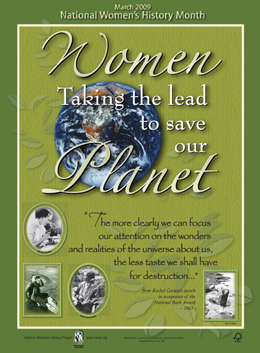Women’s History Month
 contribution to the arts, sciences, politics and society. Throughout March, events and activities take place throughout schools and public institutions in the United States; a specific theme is chosen each year. In 2009, Women’s History Month has honoured women who have played a leading role in the green movement.
contribution to the arts, sciences, politics and society. Throughout March, events and activities take place throughout schools and public institutions in the United States; a specific theme is chosen each year. In 2009, Women’s History Month has honoured women who have played a leading role in the green movement.
History
Prior to the 1970s, the study of women in history was considered to be not ‘worthwhile’ or serious’ and was marginalised in university history departments. Due to the rise of feminism, interest in women’s history increased at academic level as well as in public consciousness. In 1978, the Education Task Force of the Sonoma County (California) Commission on the Status of Women initiated a “Women’s History Week” celebration. The week of March 8 was chosen to coincide with International Women's Day . The success of the event was replicated in schools throughout the state the following year.
Leaders from the California group decided to share their project with the Women’s History Institute at Sarah Lawrence College; at this meeting, all participants agreed to support an effort to have Congress declare a national Women’s History Week. n 1980, the National Women’s History Project (NWHP) was founded in Santa Rosa, California to broadcast women’s historical achievements.
In 1981, Sen. Orrin Hatch and Rep. Barbara Mikulski cosponsored the first Joint Congressional Resolution proclaiming a “Women’s History Week.”
In 1987, the National Women’s History Project petitioned Congress to expand the celebration to the entire month of March.
Mission and programmes
- to teach as many people as possible about women’s role in history
- promote a multicultural women’s history perspective by honoring women of diverse cultural, ethnic, occupational, racial, class, and regional backgrounds.
- designed, developed, and produced more than 200 multicultural women’s history resource materials
- conduct women’s history training sessions and women’s historic site tours.
Sources
- http://www.nwhp.org
- http://www.loc.gov/topics/womenshistory
- http://en.wikipedia.org/wiki/Women%27s_History_Month


